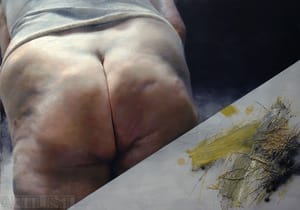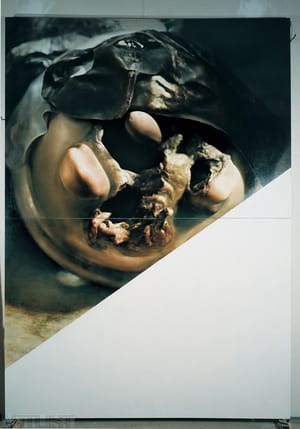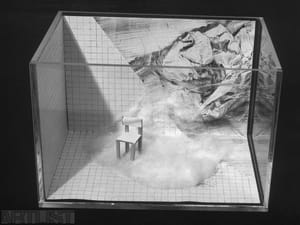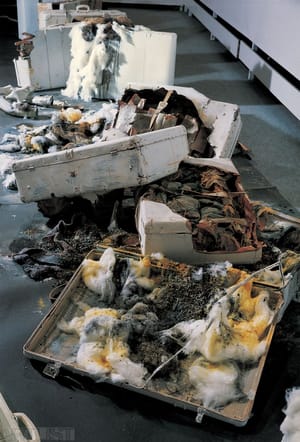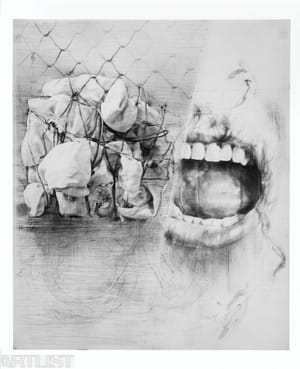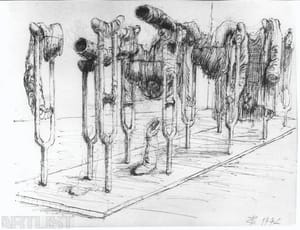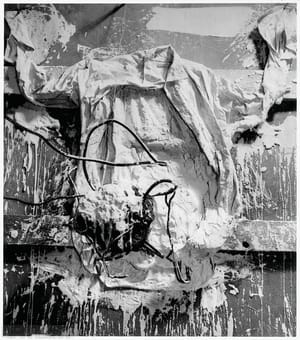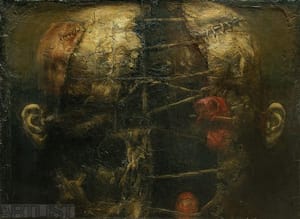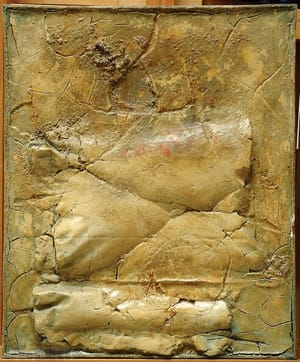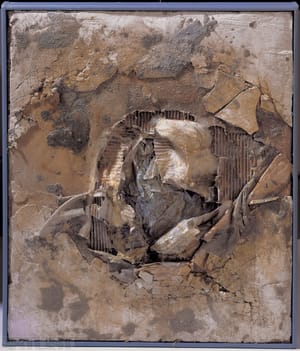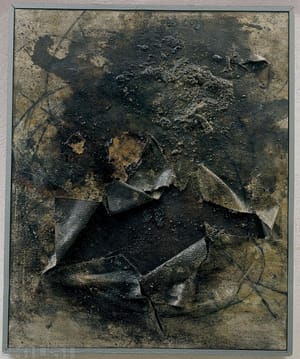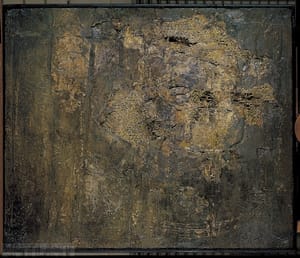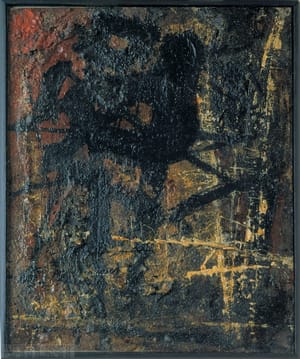- First Name
- Zdeněk
- Surname
- Beran
- Born
- 1937
- Birth place
- Dolní Dobrouč v Čechách
- Place of work
- Prague
- Website
- www.zdenekberan.cz
- Died
- 2014
- Keywords
- CSU Library
- ↳ Find in the catalogue
About artist
Zdeněk Beran began in the late 1950s with expressive-styled figurative pictures. He was inspired by the Czech avant-garde (B. Kubišta), though we also find a connection with modern, namely French painting (G. Roualt). He then turned to Tachism (e.g. his Action studies from 1958). His debut was then marked by his affiliation with the “informel” circle’s Konfrontace (Confrontation) exhibitions that took place in 1960 and that introduced quite a reversal in art's path. The Konfrontace artists rejected any kind of continuation in the pre-war tradition and embraced contemporary trends that they saw in, for instance, the work of Jean Dubuffet.
In his informel objects, Beran often used redundant materials (wood, metal, sand, cardboard, fibreboard, straw, rope, textile, cotton, tiles, paint), which stacked into ever growing reliefs that cut through and create textures from which atmosphere of decay radiates. This motif of decomposition became characteristic of his other works as well – objects that were created in later years. In the latter half of the 1960s the artist also returned to figuration in paintings and reliefs. The Rembrandt-like painted abstract Dýňovitá hlava (Pumpkin head) is a wildly imaginative picture on the existential feelings of man. It does not lack for dramatically powerful feeling of decay and destruction. This basic direction of emotional reflection in Beran's work is fully applied in his famous environmental work Rehabilitační oddělení Dr. Dr. a jeho transformace (Rehabilitation department Dr. Dr. and its transformation). The installation was first made in 1970-71 as an interior work in the space of one building in the Karlín quarter of Prague. The space, itself subject to unstoppable devastation, brought to mind a tiled hospital room filled with metal beds, hangers and strangely bandaged torsos of dummies. Later, after 1989, the installation was “buried” in a deep pit and covered with sheet glass.
It was then covered with dirt and in 2000 again exhumed so that part of the installation could be exhibited in the National Gallery. Rehabilitační oddělení was a logical result of my personal scepticism rooted in my internal resistance to modernist-like positive postulates, like the kind formulated in our country with blind faith in universal progress in the latter half of the 1960s in particular,” said Beran. The themes of decrepitude, devastation and futility also appear in the Kufry (Suitcases) series (subtitled Fear of existence in a suitcase) made in 1976. Various destroyed objects spilling out like the entrails of the suitcases that Beran adorns with tiles and adds hyper-realistic drawings to. In 1990, Beran exhibited suitcases and other typically dilapidated “body remains” in an environmental performance in the Terezín Fort – in an environment that enhanced the expressive nature of the works. Models of his Spatial Formations from 1983-85 move in a less emotionally charged environment. These are actually studies of installations that have never been carried out (save for one exception). The space in plexiglass boxes is equipped on two sides with “tiled” walls and small objects are installed in a miniature interior: most often a chair or bed, which are augmented by simple geometric forms (triangle, cross) and once again, as with the suitcases, featuring the artists hyper-realistic drawings.
Since the 1970s Beran has focused on large-format veristic drawing in which there appear fragments of the human body that are violated by rope, for instance, and which he used to continue to address the existential problems that constantly dogged him during the communist years. In the 1990s, he began to focus on hyper-realistic painting, in which he worked with different fragments of reality that were not always legible at first sight. Most recently, Beran has created a figurative series of nude torsos, and mainly the backsides of bodies – backs and buttocks. These are sections of the body that have been enlarged so much that the body fragment fills the picture. Beran says that he enjoys painting something that hasn’t been done here: In his view, the front parts of the body have been “historically worn out”. Existential rawness gives way here to a less biased, blunt description. With their formal reduction and enlargement, the body parts, though they’re still painted in a veristic manner to the point of photographic realism, border here on an abstract image.
- Author of the annotation
- Ivona Raimanová
CV
Studies:
1952-1956 Výtvarná škola v Praze na Vinohradech (nowadays College and High art school of Vaclav Hollar)
1956 – 1962 Akademie výtvarných umění v Praze (V. Sychra)
Employment:
1990-present Professor at the Academy of Fine Arts, Prague
Stipends:
1989 The Pollock Krasner Foundation
- Member of art groups included in ARTLIST.
- Member of art groups not included in ARTLIST.
-
od 2006 Mánes
Exhibitions
- Solo exhibitions
-
2011
Fragmenty a tristní přemalby, Galerie litera, Praha
2007
Post retrospektiva, AJG, Hlunboká n. Vlatavou
Texty a kresby z první poloviny sedmdesátých let, Galerei Ztichlá klika, Praha
Retrospektiva, Veletržní palác, NG Praha
2004
Velké torzo obrazu, Galerie Via Art, Praha
2003
Selanka staronových struktur, Galerie Navrátil, Praha
1997
Galerie 60/70, Praha
1996
Odvrácená strana obrazu, GMU, Hradec Králové
1992
Modely, Galerie Litera, Praha
- Group exhibitions not included in ARTLIST.
-
2010
Realita je víc než fikce: Asambláž jako tvůrčí princip v českém umění 60. a 70. let, Dům pánů z Kunštátu, Brno
2009
Napříč časem, Cisterciácký klášter, Osek
Transfer, Dům pánů z Kunštátu, Brno
2007
Zaostalí, Městská knihovna, Praha
2006
Amor vincit omnia, Saarländischen Galerie, Berlín
Šedesátá, Ze sbírky Galerie Zlatá husa v Praze, GU Karlovy Vary
2005
La boite en valise – oder Die Neue Welt liegt mitten Europa. AVU Praha a Vídeň
2004
Šedesátá, Ze sbírky Galerie Zlatá husa v Praze, Dům umění města Brna
Umění je abstrakce. Česká vizuální kultura 60. let. Staatlisches Museum für angewandte Kunst, Mnichov
2003
Hyperrealismus. GMU Hradec Králové
Současný akvarel, Galerie Navrátil, Praha
2002
Objekt – objekt: Metamorfózy v čase, Pražákův palác, Brno
2001
Tendence 60. let IV. Obrazy, objekty, plastiky, kresby, grafiky. Trigon Gallery, Plzeň
Objekt – objekt: Metamorfózy v čase, Dům U černé Matky Boží, Praha
100 + 1 uměleckých děl z dvacátého století, Dům U černé Matky Boží, Praha
2000
Dva konce století 1900 2000, Dům U černé Matky Boží, Praha
Současná minulost: česká postmoderní moderna 1960-2000, AJG, Hluboká n. Vlatavou
Ozvěny kubismu v českém výtvarném umění, Dům U černé Matky Boží, Praha
1999
Umění zrychleného času. Česká výtvarná scéna 1958-1968, Dům U černé Matky Boží, Praha Praha
1998
Podoby fantaskna v českém výtvarném umění 20. století, Hluboká n. Vltavou
Tendence 60. let. Informel, nová figurace, konstruktivní umění. Trigon Gallery, Plzeň
1997
České imaginativní umění, Galerie Rudolfinum, Praha
1996
Umění zastaveného času. Česká výtvarná scéna 1969-1985, Dům U černé Matky Boží, Praha, GVU Cheb, Brno
1995
Kresba nebo obraz, Palác Kinských, Praha
1993
Skutečnost a iluze, Hluboká n. Vltavou
1992
České výtvarné umění 1900-1960, Středočeská galerie, Praha
Osobnosti českého umění, Karolinum, Praha
1991
Šedá cihla 78/1991, Dům umění Opava a Galerie U Bílého jednorožce, Klatovy
Tradition und Avantgarde in Prag, Kunsthalle Osnabrück a Rheinisches Landesmuseum, Bonn
Český informel: Průkopníci abstrakce z let 1957-1964, Staroměstská radnice, Praha
1990
Zaostalí, Lidový dům, Praha
Zaostalí, Galerie Nová síň, Praha
Dialog 90, Mánes, Praha
1988
Forum 1988, Holešovická tržnice, Praha
1986
České umění 20. století, AJG, Hluboká n. Vltavou
1984
Realismus Berlin-Prag, Galerie Dialog e. V., Berlin
1981
Netvořice 81, Dům Bedřicha Dlouhého, Netvořice
1980
Terezín 80, Památník Terezín
Kresby, Zámek Rychnov n. Kněžnou
Pevnost, Soukromé sympozium v malé pevnosti v Terezíně
1967
Fantazijní aspekty současného českého umění, Oblastní galerie Vysočiny, Jihlava
1960
Konfrontace II., Ateliér Aleše Veselého, Praha
Konfrontace I., Ateliér Jiřího Valenty, Praha
- Collections
-
Alšova jihočeská galerie v Hluboké nad Vltavou, Hluboká nad Vltavou
Centre Georges Pompidou, Paříž České muzeum výtvarných umění, Praha
Galerie hlavního města Prahy, Praha
Galerie Mayerrischer Wald, Zant
Galerie moderního umění v Hradci Králové, Hradec Králové (Hradec Králové)
Galerie Sonnenring, Mnichov
Galerie Sonnenring, Münster
Ministerium of the International Avantgarde, Milano
Musée National d'Art Moderne, Paříž
Muzeum umění Olomouc, Olomouc
Národní galerie v Praze, Praha
Památník Terezín, Terezín
Monography
- Monography
Zdeněk Beran. Texty: Zdeněk Beran, Jindřich Chalupecký, Milan Knížák, Jan kříž, Jiří Machalický, Mahulena Nešlehová, Patrik Šimon, Petr Wittlich. Národní galerie v Praze 2007.
- Articles
Wagner Radan: Dvě strany jedné mince, A2 kulturní týdeník, s. 8
